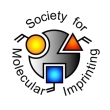
Authors: Çorman ME, Armutcu C, Uzun L, Say R, Denizli A
Article Title: Self-oriented nanoparticles for site-selective immunoglobulin G recognition via epitope imprinting approach.
Publication date: 2014
Journal: Colloids and Surfaces B: Biointerfaces
Volume: 123
Page numbers: 831-837.
DOI: 10.1016/j.colsurfb.2014.10.020
Alternative URL: http://www.sciencedirect.com/science/article/pii/S0927776514005670
Abstract: Molecular imprinting is a polymerization technique that provides synthetic analogs for template molecules. Molecularly imprinted polymers (MIPs) have gained much attention due to their unique properties such as selectivity and specificity for target molecules. In this study, we focused on the development of polymeric materials with molecular recognition ability, so molecular imprinting was combined with miniemulsion polymerization to synthesize self-orienting nanoparticles through the use of an epitope imprinting approach. Thus, l-lysine imprinted nanoparticles (LMIP) were synthesized via miniemulsion polymerization technique. Immunoglobulin G (IgG) was then bound to the cavities that specifically formed for l-lysine molecules that are typically found at the C-terminus of the Fc region of antibody molecules. The resulting nanoparticles makes it possible to minimize the nonspecific interaction between monomer and template molecules. In addition, the orientation of the entire IgG molecule was controlled, and random imprinting of the IgG was prevented. The optimum conditions were determined for IgG recognition using the imprinted nanoparticles. The selectivity of the nanoparticles against IgG molecules was also evaluated using albumin and hemoglobin as competitor molecules. In order to show the self-orientation capability of imprinted nanoparticles, human serum albumin (HSA) adsorption onto both the plain nanoparticles and immobilized nanoparticles by anti-human serum albumin antibody (anti-HSA antibody) was also carried out. Due to anti-HSA antibody immobilization on the imprinted nanoparticles, the adsorption capability of nanoparticles against HSA molecules vigorously enhanced. It is proved that the oriented immobilization of antibodies was appropriately succeeded
Template and target information: protein, immunoglobulin G, IgG
Author keywords: l-Lysine, Molecularly imprinted nanoparticles, Self-orientation, antibody, Anti-HSA



Join the Society for Molecular Imprinting

New items RSS feed
Sign-up for e-mail updates:
Choose between receiving an occasional newsletter or more frequent e-mail alerts.
Click here to go to the sign-up page.
Is your name elemental or peptidic? Enter your name and find out by clicking either of the buttons below!
Other products you may like:
 MIPdatabase
MIPdatabase









